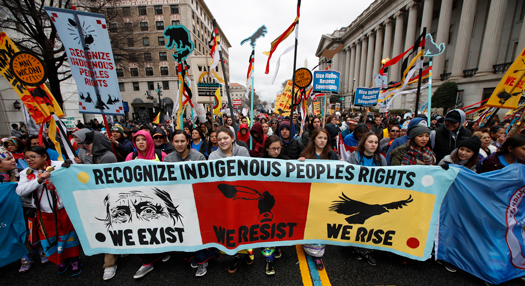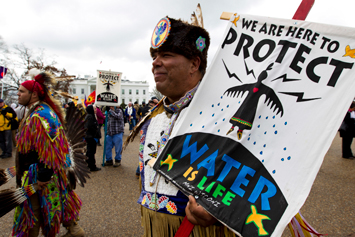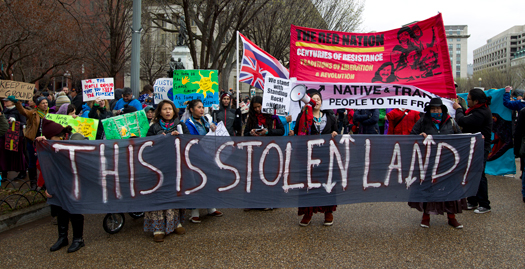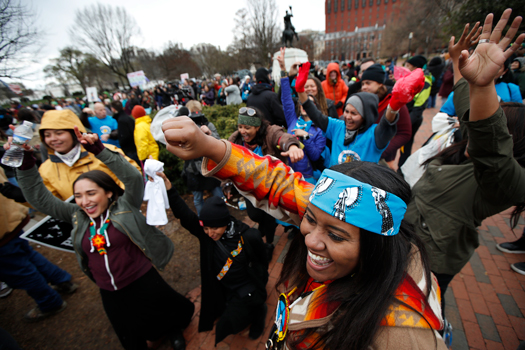Native Americans Remain Resilient And Vigilant In Face Of Continued Oppression
By Bryan Crawford -Contributing Writer- | Last updated: Nov 14, 2017 - 2:37:15 PMWhat's your opinion on this article?

American Indians and their supporters march toward the White House in Washington, March 10, to rally against continued construction of the disputed Dakota Access pipeline. Photo: AP/ Wide World photos
|
While November may be a celebration of Indigenous peoples, presented as Native American Heritage Month, it’s important to understand the socioeconomic conditions that affect Native Americans, keeping them in a lower-class state, despite being original inhabitants and occupants of the Americas.
As families prepare to observe “Thanksgiving” by spending time with one another and participating in a celebratory feast, activists caution not to get caught up in the perpetual myth and misconception history paints of early-American settlers known as Pilgrims, showing gratitude to the Native American and Indigenous peoples of this land.

American Indians and their supporters protest outside of the White House, March 10, in Washington, to rally against the construction of the disputed Dakota Access oil pipeline.
|
The Native American struggle may have been thrust back into the national spotlight more recently, at the Standing Rock Indian Reservation in North Dakota where protesters from around the country converged to express their opposition to construction of the Dakota Access Pipeline.
For 10 months, with Standing Rock as the backdrop, many people in the U.S. became aware of the many issues still being faced by Indigenous peoples who, in many ways, have become forgotten members of society.
However, when you take a deep dive into some of the challenges the 567 federally recognized Native American tribes and their corresponding communities face as it relates to police brutality, poor education, mass incarceration, drug abuse and other issues you’ll quickly see that for many Indigenous people living on reservations, life is virtually no different—and in many respects, is worse— than Black and Brown people who live in the ghettos and barrios of this country.
“Native American people are the oppressed, under the oppressed,” Black and Native American activist Yonasda Lonewolf, one of Standing Rock’s most visible faces of resistance, told The Final Call.
“Native communities are very poor. Of all the negative things that affect oppressed people, we are at the highest percentile— whether it’s suicide, diabetes, police brutality, income inequality or unemployment, we’re extremely affected,” said Ms. Lonewolf, daughter of the late Oglala Sioux activist Wauneta Lonewolf.
For example, from 1999 to 2013, the CDC (Centers for Disease Control and Prevention) found that Native American deaths at the hands of police per capita was equal to that of Black people, double that of Latinos, but three times higher than White people in the United States.
Just recently, 14-year-old Jason Pero was killed outside his home in Wisconsin on the Bad River Band of the Lake Superior Chippewa reservation. Ashland County sheriff’s deputy Brock Mrdjenovich shot the 8th grader, who he says ignored commands to drop a large butcher knife he was allegedly holding in his hand.
As a group, Native Americans have a comparable poverty rate to that of Blacks and Latinos, but is much higher than the National average since one-in-four Native Americans live in extreme poverty. At Standing Rock, for example, the poverty rate is 43 percent, triple the National average, according to data from the U.S. Census Bureau.
“We refer to North Dakota as the ‘deep North,’” said Winona LaDuke, a Native American environmental activist, Harvard alum and executive director of Honor the Earth, a nonprofit supporting environmental justice for Indigenous people.
“Hatred for Indian people is really high there. Every demographic, statistic for these people is very bad—incarceration rates, poverty rates,” Ms. LaDuke said during a recent address at the Johns Hopkins University Forums on Race in America. “Two of the poorest towns in the country are in the Standing Rock reservation. It’s really a huge justice issue.”
“On reservations, the living conditions are comparable to third-world nations. It’s tragic,” Levi Rickert, editor of Native News Online and tribal member of the Prairie Band Potawatomi Nation, told The Final Call. “There’s high levels of poverty. Some people don’t even have running water. It’s frustrating because it’s been this way for so long and things aren’t moving fast enough in terms of getting better.”

|

American Indians and their supporters rally in Lafayette Park. Photos: AP/Wide World photos
|
Mr. Rickert stated that when Native Americans do receive attention from those outside of the reservation and the general Indigenous community—such as from the federal government or large corporations—it’s usually due to the natural resources that sit under their feet that they want to control. This is what sparked the conflict in Standing Rock.
“This current administration has reached out to Native people, but it’s only because we sit on one-fifth of the nation’s valuable and untapped energy sources, whether it be oil, coal natural gas, or whatever,” Mr. Rickert explained.
“All of a sudden they want to come and get more. But there’s been resistance from tribal leaders, and rightfully so. Their attitude is leave us alone. When they find out our lands are rich with the things they want—and whether you want to call it corporate greed or government greed—they come in and rape the land of the natural resources and then leave us for dead.”
In Standing Rock, activists and protestors were not able to prevent the Dakota Access Pipeline from being completed, but their efforts did expose the lengths that Energy Transfer Partners, the company building the pipeline, took to forcefully oppose the pushback and further marginalize the Native American people on their own land.
TigerSwan, which was originally formed as a private counter-terrorism security contractor used by the U.S. military and State Department and conducted COINTELPRO style operations in the Middle East, was hired by Energy Transfer Partners to suppress what the company called, “an ideologically driven insurgency with a strong religious component,” that “generally followed the jihadist insurgency model.”
Internal TigerSwan documents provide a detailed picture of how the mercenary firm surveilled Dakota Access Pipeline opponents and infiltrated protest camps, noted online publication The Intercept.
“Myself, as well as others who were on the front lines at Standing Rock, have been attacked, both online and also in person by Tiger- Swan agents,” Ms. Lonewolf said. “There had also been a huge presence of people posing as Natives causing disruptions on the ground at Standing Rock. Come to find out they were hired by TigerSwan to keep things divisive. There was also Russians hired to pose as online Standing Rock activists. So, the same kinds of COINTELPRO tactics used by the FBI and CIA, are now being used by corporations to infiltrate and suppress movements,” she argued.
“That is part of the crisis that we have in this country,” Ms. LaDuke said. “Neither Mother Earth nor the rest of us have the same rights as a corporation.”
Highway of tears
Native Americans don’t just face extreme challenges in America. In Canada, there are approximately 1.4 million Indigenous people in the country who, according to Canadian Prime Minister Justin Trudeau, have suffered, “humiliation, neglect and abuse.” Trudeau’s comments came during a September address to the UN General Assembly.
In British Columbia, there have been so many Indigenous women and girls who have gone missing or found murdered along a Highway 16 in the province— stretching 450 miles—that it has been called the Highway of Tears. Across the country, the Royal Canadian Mounted Police have recorded approximately 1,200 cases of missing Indigenous women and girls, but the Native Women’s Association of Canada puts its estimate at 4,000. While Indigenous women in Canada make up just four percent of the total female population in the country, they represent 16 percent of all women murdered.
“Indigenous people have the highest percentile of women who go missing because of the over-sexualization of the portrayals of Native women. Throughout Canada it’s become an epidemic; it’s horrible,” explained Ms. Lonewolf, who also touched on a similar issue and concern for Indigenous women present at Standing Rock.
“Another reason we were fighting so hard against these oil pipelines being built is because they attract man camps, which are basically used for sex trafficking,” she said. “So besides messing up the earth, they also brought in the culture of sex trafficking, kidnapping and murdering Native women. What we’ve been learning is that the Indigenous women who go missing are put on boats and sent to places like Europe where they are being sold as sex slaves.”
Seeding Sovereignty, an organization created to raise both awareness and support for Native people and the issues they face, recently commissioned Jackie Fawn, a Native American and Filipino artist and environmental activist, to create a piece honoring Missing and Murdered Indigenous Women (MMIW).
“Our sisters, daughters, our women [who] have been stolen, but never for one second forgotten, are tormented by the poison of the black snake,” Ms. Fawn wrote regarding the piece on her Facebook page, ‘Jackie Fawn Illustrations.’
“With the oil industry comes the man camps that do the dirty work, and with those man camps come the violence and abuse against our peoples.”
Despite the challenges they face, which receive very little attention and oftentimes go completely ignored outside of their community, Indigenous people in the United States and Canada, have remained remarkably resilient under extremely oppressive and dangerous conditions. The resiliency they display is similar to that of Black people who suffer under the same oppressive force.
“I talk to Native people all the time who tell me that they used to drink and were alcoholics, until they got deeper into their culture and found a better way to live,” Mr. Rickert explained. “All of us—whether White, Black, Red, Brown or Yellow— have the same situations that we deal with,” he explained.
“There are some core challenges that seem to span all of human nature and impact us in a negative way. But Native people have a pride in our heritage and our culture. We pray to the Creator and we thank Him for making the trees, the air, the wind, the sun. We thank Him for giving us life, or a beautiful day, good weather, whatever. It’s the vibrancy of that which keeps Native people going,” said Mr. Rickert.
INSIDE STORIES AND REVIEWS
-
-
About Harriett ... and the Negro Hollywood Road Show
By Rabiah Muhammad, Guest Columnist » Full Story -
Skepticism greets Jay-Z, NFL talk of inspiring change
By Bryan 18X Crawford and Richard B. Muhammad The Final Call Newspaper @TheFinalCall » Full Story -
The painful problem of Black girls and suicide
By Charlene Muhammad -National Correspondent- » Full Story -
Exploitation of Innocence - Report: Perceptions, policies hurting Black girls
By Charlene Muhammad -National Correspondent- » Full Story -
Big Ballin: Big ideas fuel a father’s Big Baller Brand and brash business sense
By Bryan Crawford -Contributing Writer- » Full Story






 Click Here Stay Connected!
Click Here Stay Connected!








